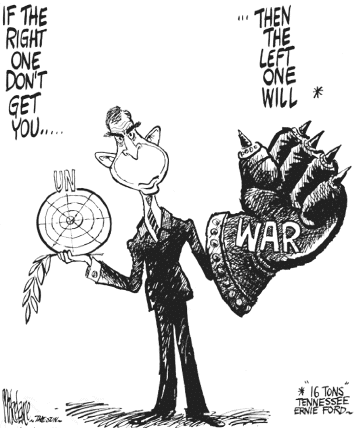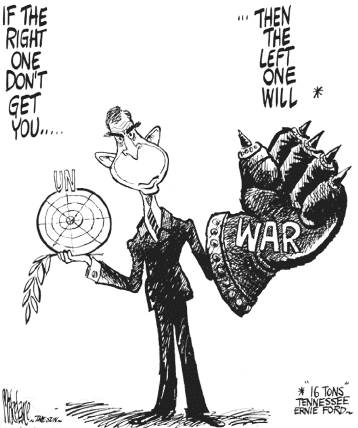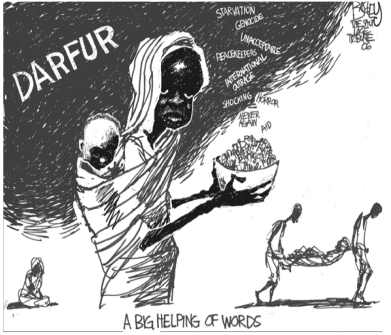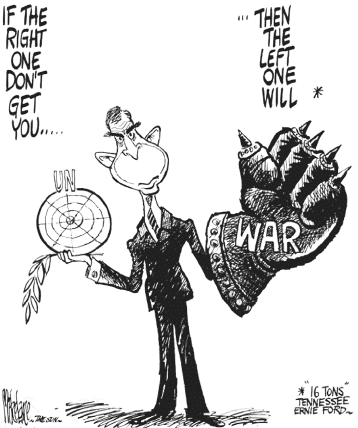Test: International Organizations- Case Based Type Questions - 1 - Humanities/Arts MCQ
10 Questions MCQ Test Political Science Class 12 - Test: International Organizations- Case Based Type Questions - 1
Study the cartoon given below carefully and answer the questions that follow.

Q. How has US dominated the world?

Study the cartoon given below carefully and answer the questions that follow.

Q. What does this cartoon depict?

Study the cartoon given below carefully and answer the questions that follow.

Q. Why this cartoon is not relevant today?

Read the following paragraph and answer the questions that follows:
The International Monetary Fund (IMF) is an international organisation that oversees those financial institutions and regulations that act at the international level. The IMF has 189 member countries (as on 12 April 2016) but they do not enjoy an equal say. The G-7 members US (16.52%), Japan (6.15%), Germany (5.32%), France (4.03%), UK (4.03%), Italy (3.02%) and Canada (2.22%) have 41.29% of the votes. China (6.09%), India (2.64%), Russia (2.59%) Brazil (2.22%) and Saudi Arabia (2.02%) are the other major members.
The World Bank was created during the Second World War in 1944. Its activities are focused on the developing countries. It works for human development (education, health), agriculture and rural development (irrigation, rural services), environmental protection (pollution reduction, establishing and enforcing regulations), infrastructure (roads, urban regeneration, and electricity) and governance (anti-corruption, development of legal institutions). It provides loans and grants to the member-countries. In this way, it exercises enormous influence on the economic policies of developing countries. It is often criticised for setting the economic agenda of the poorer nations, attaching stringent conditions to its loans and forcing free market reforms.
Q. What is the share of Canada in IMF?
Read the following paragraph and answer the questions that follows:
The International Monetary Fund (IMF) is an international organisation that oversees those financial institutions and regulations that act at the international level. The IMF has 189 member countries (as on 12 April 2016) but they do not enjoy an equal say. The G-7 members US (16.52%), Japan (6.15%), Germany (5.32%), France (4.03%), UK (4.03%), Italy (3.02%) and Canada (2.22%) have 41.29% of the votes. China (6.09%), India (2.64%), Russia (2.59%) Brazil (2.22%) and Saudi Arabia (2.02%) are the other major members.
The World Bank was created during the Second World War in 1944. Its activities are focused on the developing countries. It works for human development (education, health), agriculture and rural development (irrigation, rural services), environmental protection (pollution reduction, establishing and enforcing regulations), infrastructure (roads, urban regeneration, and electricity) and governance (anti-corruption, development of legal institutions). It provides loans and grants to the member-countries. In this way, it exercises enormous influence on the economic policies of developing countries. It is often criticised for setting the economic agenda of the poorer nations, attaching stringent conditions to its loans and forcing free market reforms.
Q. The World Bank is criticized for what?
Read the following paragraph and answer the questions that follows:
The International Monetary Fund (IMF) is an international organisation that oversees those financial institutions and regulations that act at the international level. The IMF has 189 member countries (as on 12 April 2016) but they do not enjoy an equal say. The G-7 members US (16.52%), Japan (6.15%), Germany (5.32%), France (4.03%), UK (4.03%), Italy (3.02%) and Canada (2.22%) have 41.29% of the votes. China (6.09%), India (2.64%), Russia (2.59%) Brazil (2.22%) and Saudi Arabia (2.02%) are the other major members.
The World Bank was created during the Second World War in 1944. Its activities are focused on the developing countries. It works for human development (education, health), agriculture and rural development (irrigation, rural services), environmental protection (pollution reduction, establishing and enforcing regulations), infrastructure (roads, urban regeneration, and electricity) and governance (anti-corruption, development of legal institutions). It provides loans and grants to the member-countries. In this way, it exercises enormous influence on the economic policies of developing countries. It is often criticised for setting the economic agenda of the poorer nations, attaching stringent conditions to its loans and forcing free market reforms.
Q. As per April 2016, how many members did IMF have?
Read the following paragraph and answer the questions that follows:
The International Monetary Fund (IMF) is an international organisation that oversees those financial institutions and regulations that act at the international level. The IMF has 189 member countries (as on 12 April 2016) but they do not enjoy an equal say. The G-7 members US (16.52%), Japan (6.15%), Germany (5.32%), France (4.03%), UK (4.03%), Italy (3.02%) and Canada (2.22%) have 41.29% of the votes. China (6.09%), India (2.64%), Russia (2.59%) Brazil (2.22%) and Saudi Arabia (2.02%) are the other major members.
The World Bank was created during the Second World War in 1944. Its activities are focused on the developing countries. It works for human development (education, health), agriculture and rural development (irrigation, rural services), environmental protection (pollution reduction, establishing and enforcing regulations), infrastructure (roads, urban regeneration, and electricity) and governance (anti-corruption, development of legal institutions). It provides loans and grants to the member-countries. In this way, it exercises enormous influence on the economic policies of developing countries. It is often criticised for setting the economic agenda of the poorer nations, attaching stringent conditions to its loans and forcing free market reforms.
Q. When was the inception of World Bank?
Study the picture given below and answer the questions that follow:

Q. What type of crises is shown in the cartoon?
Study the picture given below and answer the questions that follow:

Q. What was the cause of Darfur crisis?
Study the cartoon given below carefully and answer the questions that follow.

Q. What have been the reasons for immense influence of US on UN?
|
34 videos|433 docs|77 tests
|














